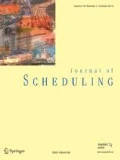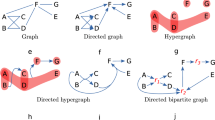Abstract
In this paper, we describe RanGen, a random network generator for generating activity-on-the-node networks and accompanying data for different classes of project scheduling problems. The objective is to construct random networks which satisfy preset values of the parameters used to control the hardness of a problem instance. Both parameters which are related to the network topology and resource-related parameters are implemented. The network generator meets the shortcomings of former network generators since it employs a wide range of different parameters which have been shown to serve as possible predictors of the hardness of different project scheduling problems. Some of them have been implemented in former network generators while others have not.
Similar content being viewed by others
REFERENCES
Alvarez-Valdes, R. and J. M. Tamarit, “Heuristic algorithms for resource-constrained project scheduling: A review and empirical analysis,” in R. Slowinski J. Weglarz (eds.), Advances in Project Scheduling, Elsevier, Amsterdam, 1989.
Agrawal, M. K., S. E. Elmaghraby, and W. S. Herroelen, “DAGEN: A generator of testsets for project activity nets,” Eur. J. Oper. Res., 90, 376-382 (1996).
Bein, W. W., J. Kamburowski, and M. F. M. Stallmann, “Optimal reduction of two-terminal directed acyclic graphs,” SIAM J. Comput., 21, 1112-1129 (1992).
Brucker, P., A. Drexl, R. Möhring, K. Neumann, and E. Pesch, “Resource-constrained project scheduling: Notation, classification, models, and methods,” Eur. J. Oper. Res., 112, 3-41 (1999).
Cooper, D. F., “Heuristics for scheduling resource-constrained projects: An experimental investigation,” Manag. Sci., 22, 1186-1194 (1976).
Dar-El, E. M., “MALB—A heuristic technique for balancing large single-model assembly lines,” IIE Trans., 5, 343-356 (1973).
Davis, E. W., “Project network summary measures and constrained resource scheduling,” IIE Trans., 7, 132-142 (1975).
Davies, E. M., “An experimental investigation of resource allocation in multiactivity projects,” Oper. Res. Quart., 24, 587-591 (1973).
Demeulemeester, E., B. Dodin, and W. Herroelen, “A random activity network generator,” Oper. Res., 41, 972-980 (1993).
Demeulemeester, E., B. De Reyck, B. Foubert, W. Herroelen, and M. Vanhoucke, “New computational results on the discrete time/cost trade-off function,” J. Oper. Res. Soc., 49, 1153-1163 (1998).
De Reyck, B., “On the use of the restrictiveness as a measure of complexity for resource-constrained project scheduling,” Research Report 9535. Department of Applied Economics, Katholieke Universiteit Leuven, Belgium, 1995.
De Reyck, B. and W. Herroelen, “On the use of the complexity index as a measure of complexity in activity networks.” Eur. J. Oper. Res., 91, 347-366 (1996).
Elmaghraby, S. E., “Activity nets: A guided tour through some recent developments,” Eur. J. Oper. Res., 82, 383-408 (1995).
Elmaghraby, S. E. and W. S. Herroelen, “On the measurement of complexity in activity networks,” Eur. J. Oper. Res., 5, 223-234 (1980).
Ford, J. E. and D. R. Fulkerson, Flows in Networks, Princeton University Press, Princeton, New Jersy, 1962.
Herroelen, W. and B. De Reyck, “Phase transitions in project scheduling,” J. Oper. Res. Soc., 50, 148-156 (1999).
Herroelen, W., B. De Reyck, and E. Demeulemeester, “Resource-constrained project scheduling: A survey of recent developments,” Comput. Oper. Res., 25, 279-302 (1998).
Icmeli, O., S. S. Erengüç, and C. J. Zappe, “Project scheduling problems: A survey,” International J. Oper. Prod. Manag., 13, 80-91 (1993).
Kaimann, R. A., “Coefficient of network complexity.” Manag. Sci., 21, 172-177 (1974).
Kaimann, R. A., “Coefficient of network complexity: erratum.” Manag. Sci., 21, 1211-1212 (1975).
Kamburowski, J., D. J. Michael and M. F. M. Stallmann, “Optimal construction of project activity networks,” Proceedings of the 1992 Annual Meeting of the Decision Sciences Institute, San Francisco, 1992, pp. 1424-1426.
Kao, E. P. C. and M. Queranne, “On dynamic programming methods for assembly line balancing,” Oper. Res., 30, 375-390 (1982).
Kolisch, R., A. Sprecher, and A. Drexl, “Characterization and generation of a general class of resource-constrained project scheduling problems,” Manag. Sci., 41, 1693-1703 (1995).
Mastor, A. A., “An experimental and comparative evaluation of production line balancing techniques,” Manag. Sci., 16, 728-746 (1970).
Özdamar, L. and G. Ulusoy, “A survey on the resource-constrained project scheduling problem,” IIE Trans., 27, 574-586 (1995).
Pascoe, T. L., “Allocation of resources—CPM,” Revue Française de Recherche Opérationelle, 38, 31-38 (1966).
Patterson, J. H., “Project scheduling: The effects of problem structure on heuristic scheduling,” Naval Res. Logist., 23, 95-123. (1976).
Patterson, J. H., “A comparison of exact procedures for solving the multiple-constrained resource project scheduling problem,” Manag. Sci., 20, 767-784 (1984).
Schwindt, C., “A new problem generator for different resource-constrained project scheduling problems with minimal and maximal time lags,” WIOR-Report-449, Institut für Wirtschaftstheorie und Operations Research, University of Karlsruhe (1995).
Thesen, A., “Measures of the restrictiveness of project networks,” Networks, 7, 193-208 (1977).
Vanhoucke, M., “Exact algorithms for various project scheduling problems: Nonregular measures of performance and time/cost trade-offs.” Unpublished PhD Dissertation (2001).
Vanhoucke, M., E. Demeulemeester, and W. Herroelen, “On maximizing the net present value of a project under renewable resource constraints,” Manag. Sci., 47, 1113-1121 (2001).
Author information
Authors and Affiliations
Rights and permissions
About this article
Cite this article
Demeulemeester, E., Vanhoucke, M. & Herroelen, W. RanGen: A Random Network Generator for Activity-on-the-Node Networks. Journal of Scheduling 6, 17–38 (2003). https://doi.org/10.1023/A:1022283403119
Issue Date:
DOI: https://doi.org/10.1023/A:1022283403119




